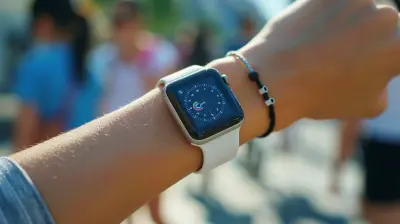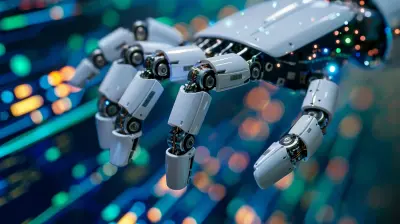How Smart Dust Could Change Data Collection Forever
8 May 2025
Imagine a world where tiny, dust-sized sensors float around you, collecting data from virtually every corner of your environment. It sounds like something out of a science fiction movie, right? But it's not. This is a concept known as Smart Dust, and it’s not just a far-off dream—it’s a technology that could change the way we collect, analyze, and interact with data forever.
In this article, we’re going to dive deep into what smart dust is, how it works, and why it could revolutionize everything from healthcare to environmental monitoring. Buckle up, because the future is closer than you think!

What Exactly Is Smart Dust?
Let’s start with the basics. Smart Dust refers to a network of tiny microelectromechanical systems (MEMS) that can detect things like temperature, light, pressure, vibration, and even chemical changes. These are so small that they resemble specks of dust—hence the name "Smart Dust."But don’t be fooled by their size. Despite being so tiny, these particles are packed with sensors, wireless communication capabilities, and sometimes even computing power. Once released into an environment, they can collect and transmit data in real-time, giving us unprecedented insight into the world around us.
How Small Are We Talking About?
When I say small, I mean really small. We're talking about devices that can be as tiny as a grain of salt. To put it into perspective, imagine sprinkling a handful of sand into the air. Now imagine each of those grains of sand having the ability to sense and transmit data back to a central system. That’s essentially how smart dust works.
How Does Smart Dust Work?
The brilliance of smart dust lies in its simplicity and complexity at the same time. Each tiny particle, or "mote", in the smart dust network operates autonomously. These motes communicate with each other and with larger systems, sending back collected data to a central hub for analysis. Pretty cool, right?Components of Smart Dust
To get a clearer picture of how these little motes work, let’s break down their key components:1. Sensors: Each mote is equipped with one or more sensors to collect data—whether it's temperature, humidity, or even magnetic fields.
2. Power Source: Despite their size, motes need energy. Most rely on tiny batteries, but researchers are also developing ways for them to harvest energy from their environment, like solar power or vibrations.
3. Communication Module: This is what allows each mote to "talk" to its neighbors and to the central system. They use wireless communication, typically relying on radio frequencies or infrared.
4. Processor: Some motes come equipped with tiny processors that allow them to perform basic computing tasks before transmitting data.
How Do They Communicate?
Imagine this: each mote is like a small, chatty group of friends at a party. They’re constantly talking to each other, sharing information, and passing it along. They use wireless signals (kind of like how your phone uses Wi-Fi) to communicate with a base station or with other motes in the network.This type of communication is often referred to as a "mesh network." In a mesh network, each device can act as a relay point for data, meaning if one mote can't directly send information to the base station, it can pass it along to another mote that can.

Applications of Smart Dust
Now, here’s where things get really interesting. Smart dust has the potential to revolutionize countless industries, from healthcare to agriculture to urban planning. Let’s explore some of the most exciting applications.1. Healthcare: Monitoring From the Inside Out
One of the most mind-blowing uses of smart dust is in the field of healthcare. Imagine tiny sensors being injected into your body, where they can monitor your vital signs, detect early signs of disease, or even track how well a medication is working. These particles could offer real-time data without the need for invasive procedures or bulky equipment.For example, in patients with chronic conditions like diabetes, smart dust could track blood sugar levels continuously and send alerts when intervention is needed. It’s like having a personal healthcare assistant inside your body at all times!
2. Environmental Monitoring: A High-Tech Weather Report
Ever wondered how much pollution is in the air you’re breathing? Or how quickly a forest is drying out during a drought? Smart dust could be deployed to monitor environmental conditions in real time.Picture a forest scattered with smart dust motes that track temperature, humidity, and other variables. In the event of a forest fire, these sensors could provide early warnings, giving firefighters a critical head start.
3. Industrial and Urban Monitoring: The Smart Cities of the Future
Smart cities are all the rage, but imagine taking it a step further with smart dust. These tiny sensors could be dispersed throughout a city, monitoring everything from traffic patterns to air quality to structural integrity in buildings. City planners could use this data to make real-time decisions that improve efficiency and safety.For example, if a bridge is showing signs of stress or wear, smart dust sensors could alert officials before it becomes a safety hazard.
4. Agriculture: Smarter Farms, Healthier Crops
Farmers could also benefit enormously from smart dust technology. Instead of relying on traditional methods to monitor crop health, smart dust could be sprinkled across a field, tracking soil moisture, nutrient levels, and even pest activity in real time.This data would allow farmers to optimize irrigation, fertilizer use, and pest control, ensuring healthier crops and greater yields. It’s like giving the soil a voice, and it could make farming more efficient than ever before.

Challenges and Concerns
As exciting as smart dust sounds, it’s not without its challenges. Like any new technology, there are hurdles to overcome before we see widespread adoption.Privacy Issues
Given how tiny and pervasive smart dust can be, one of the biggest concerns is privacy. If these sensors are scattered around public spaces (or worse, inside our bodies), how do we ensure that our personal information isn’t being collected without our consent?For example, in a smart city, do you really want sensors tracking your every move, even if it’s for the sake of efficiency? Privacy advocates are already voicing concerns, and it’s likely that regulations will need to be put in place to protect individual rights.
Security Risks
Another challenge is security. With so many tiny devices communicating wirelessly, there’s always the risk of hacking or data breaches. If someone were to gain control of a smart dust network, they could potentially manipulate the data or use the sensors for malicious purposes.Power and Durability
Powering these tiny devices is another challenge. While some motes can harvest energy from their environment, others rely on tiny batteries that can only last so long. Researchers are working on ways to extend the battery life or find alternative energy sources, but it’s still a hurdle that needs to be addressed.The Future of Smart Dust
Despite these challenges, the future of smart dust is incredibly promising. As technology continues to advance, it’s likely that we’ll see more practical applications for these tiny sensors in both the public and private sectors.It’s not hard to imagine a future where smart dust is as commonplace as Wi-Fi. From monitoring our health to optimizing our cities, the potential applications are endless. And while there are certainly concerns to address, the benefits of this technology could far outweigh the risks.
Final Thoughts
Smart dust is one of those technologies that has the potential to completely change the way we live and interact with the world. While we're not quite there yet, advancements in MEMS technology, wireless communication, and data analytics are bringing us closer every day.It’s both exciting and a little unnerving to think about just how much data could be collected and how that data could be used. But one thing's for sure—smart dust could be the key to unlocking a smarter, more connected future. The only question is, are we ready for it?
all images in this post were generated using AI tools
Category:
Future TechAuthor:

John Peterson
Discussion
rate this article
4 comments
Caelestis Jones
What an intriguing exploration of smart dust technology! The potential for revolutionizing data collection is truly exciting. Your insights highlight not only the innovative aspects but also the far-reaching implications for various industries. Excited to see how this technology unfolds in the future!
May 24, 2025 at 10:44 AM

John Peterson
Thank you for your thoughtful comment! I'm glad you found the exploration of smart dust technology compelling. Its potential truly is exciting, and I'm eager to see its impact across industries as it develops!
Thornefield Love
This article offers a fascinating glimpse into the transformative potential of smart dust in data collection. The innovative applications discussed highlight how this technology could revolutionize various industries, enabling real-time data analytics and enhancing decision-making processes. Excited to see future developments in this area!
May 19, 2025 at 10:22 AM

John Peterson
Thank you for your insightful comment! I'm glad you found the article on smart dust's potential intriguing. Stay tuned for more updates as this technology evolves!
Rhea Harris
What an exciting read! The potential of smart dust to revolutionize data collection is mind-blowing. Can't wait to see how it unfolds!
May 17, 2025 at 10:32 AM

John Peterson
Thank you! I'm thrilled you found it exciting. The future of smart dust truly holds incredible possibilities for data collection!
Mila Moore
Exciting insights! Smart dust could really revolutionize how we gather and analyze data. Can't wait!
May 14, 2025 at 11:08 AM

John Peterson
Thank you! I'm glad you found it exciting—smart dust truly has the potential to transform data collection in remarkable ways!



